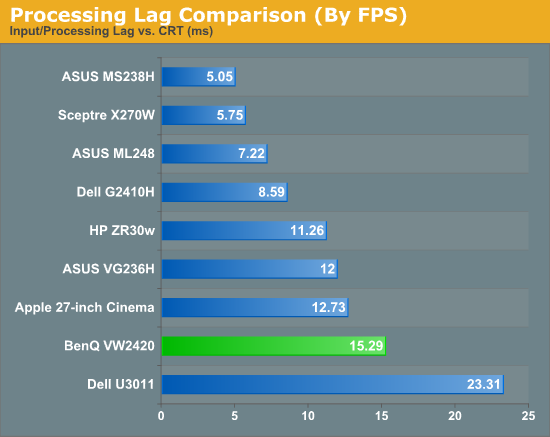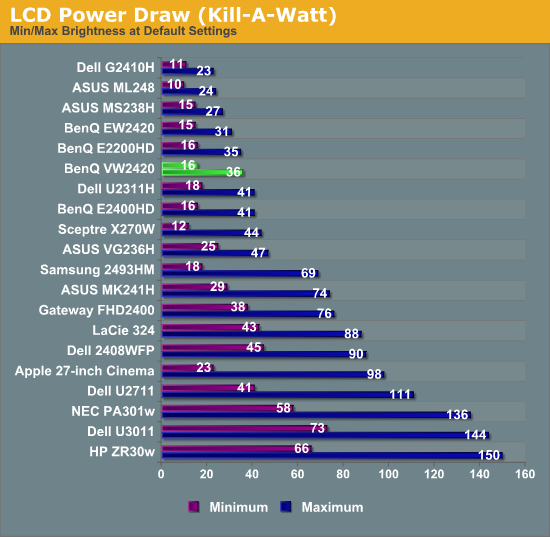BenQ VW2420H Monitor Review
by Chris Heinonen on December 10, 2011 2:45 AM ESTInput Lag and Power Use
With the lag tests, the BenQ performed adequately, offering around 1 frame of lag overall in testing. Changing the refresh speed did nothing to alter these numbers either, so 15.3 ms of lag is about what you can expect from this display. I didn’t find it distracting or bothersome in the gaming I did, but if you want the lowest lag possible you’ll still need to look for a different panel type.

The peak power use for the BenQ was pretty average for the size, with 36 watts used at full backlight power. At minimum backlight, that dropped down to 16 watts, which isn’t as low as many other displays are able to achieve at this point. Our database doesn’t have enough *VA panels to let me be certain if it’s the panel that requires more power or something in the design of the monitor, but the difference is only 4-5 watts over the best performing monitors. [Ed: Which, sadly, is probably why we're not seeing this sort of display in a laptop.]











48 Comments
View All Comments
JediJeb - Saturday, December 10, 2011 - link
The only thing worse is when the make the screen shiny too. It is why I haven't bought a new notebook as most lower priced ones now days have the reflective glossy screens that are useless unless you are using them in the dark.danchen - Saturday, December 10, 2011 - link
Will the 16:10 layout ever make a comeback ?Seems only Dell & apply are still making them.
and yeah, i agree that the shiny thick bezels are unwelcome. I am looking for 3 monitors to do an eyefinity setup, and despite any good reviews, the bezel alone will turn me away.
dingetje - Saturday, December 10, 2011 - link
benq can shove its 16:9 panel where the sun don't shine.16:9 is useful for movie watching and not much else.
kesbar - Saturday, December 10, 2011 - link
^^^^ This.Stop encouraging the 16:9 market.
BansheeX - Saturday, December 10, 2011 - link
Clinging to some tiny deviance like 16:10 is asinine. We don't want a recorded desktop to be chopped off vertically or downsampled when played back on a television or projector. We need uniformity with regards to aspect. Maybe someday they will release a 3840x2160 monitor and you resolution junkies will shut the heck up about aspects.TegiriNenashi - Monday, December 12, 2011 - link
16:10 should have been HDTV standard to begin with. (I personally find ratio 16:11 even more pleasing). It is silly living in 21st century and being forced to watch content in aspect ratio one hates (yes, I'm speaking of ridiculous short letterbox 2.41:1) .psychobriggsy - Tuesday, December 13, 2011 - link
Letterbox 2.41:1 really requires a 100" display or more. The idea is to totally immerse the viewer even if the edges aren't where the action is happening.I think that until such large TVs are mainstream DVDs and BluRays should just stick to 16:9 formats that fill the entirety of the TV screen.
TegiriNenashi - Tuesday, December 13, 2011 - link
I have 100" projector screen in 4:3 ratio for almost a decade. Its ginormous (for a small room). 100" letterbox image is much less spectacular, as you would could clearly feel the lack of height. It's all about virtual reality, filling out the full field of view -- IMAX (4:3) pushing the viewing excellence. Again those 1950 ideas of "impressive" visual are out of touch with today's reality.psychobriggsy - Tuesday, December 13, 2011 - link
I treat it as being a 1680x1050 monitor but with 240 more pixels on the edge, and 30 on the bottom, rather than being a cut down 1920x1200.What I want is a 24" 2560x1440 monitor. And in a couple of years why not a high DPI 3840x2160!
TegiriNenashi - Tuesday, December 13, 2011 - link
Do you know that given two displays with the same diagonal, the narrower one has less area? That is 16:10 being 6% smaller than 4:3, and 16:9 being even smaller: 7% less than 16:10. That is why manufacturers are so in love with "True HD" -- at consumers expense.Nevertheless 4K displays (to appear next year) are welcome development in this stagnated field. The price for 30" 2500x1600 display has been flat for 5 years -- the situation unheard of in electronics.